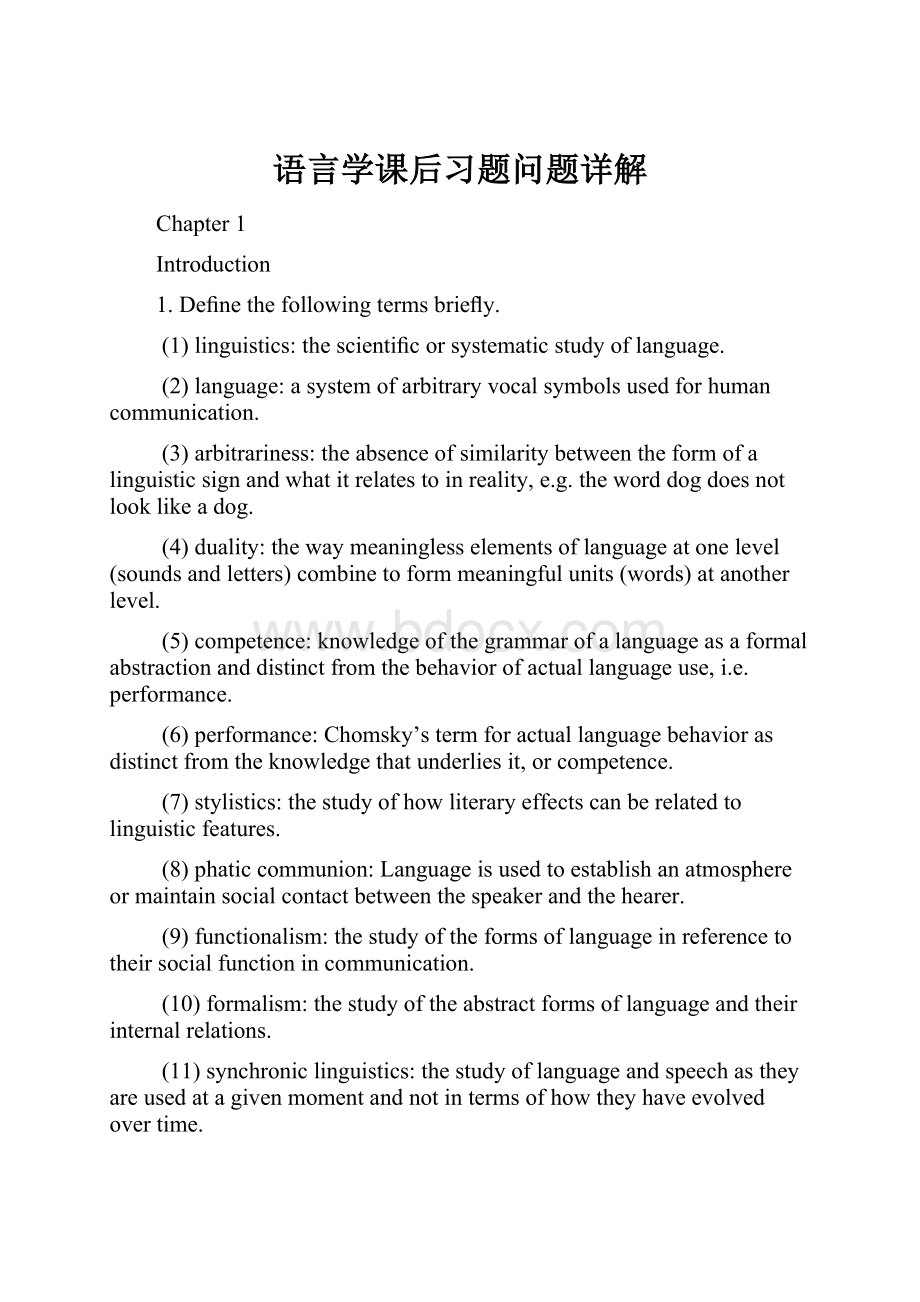语言学课后习题问题详解.docx
《语言学课后习题问题详解.docx》由会员分享,可在线阅读,更多相关《语言学课后习题问题详解.docx(32页珍藏版)》请在冰豆网上搜索。

语言学课后习题问题详解
Chapter1
Introduction
1.Definethefollowingtermsbriefly.
(1)linguistics:
thescientificorsystematicstudyoflanguage.
(2)language:
asystemofarbitraryvocalsymbolsusedforhumancommunication.
(3)arbitrariness:
theabsenceofsimilaritybetweentheformofalinguisticsignandwhatitrelatestoinreality,e.g.theworddogdoesnotlooklikeadog.
(4)duality:
thewaymeaninglesselementsoflanguageatonelevel(soundsandletters)combinetoformmeaningfulunits(words)atanotherlevel.
(5)competence:
knowledgeofthegrammarofalanguageasaformalabstractionanddistinctfromthebehaviorofactuallanguageuse,i.e.performance.
(6)performance:
Chomsky’stermforactuallanguagebehaviorasdistinctfromtheknowledgethatunderliesit,orcompetence.
(7)stylistics:
thestudyofhowliteraryeffectscanberelatedtolinguisticfeatures.
(8)phaticcommunion:
Languageisusedtoestablishanatmosphereormaintainsocialcontactbetweenthespeakerandthehearer.
(9)functionalism:
thestudyoftheformsoflanguageinreferencetotheirsocialfunctionincommunication.
(10)formalism:
thestudyoftheabstractformsoflanguageandtheirinternalrelations.
(11)synchroniclinguistics:
thestudyoflanguageandspeechastheyareusedatagivenmomentandnotintermsofhowtheyhaveevolvedovertime.
(12)diachroniclinguistics:
thestudyoflinguisticchangeovertimeincontrasttolookingatlanguageasitisusedatagivenmoment.
2.No,languageishuman-specific.Humanlanguagehassevendesignfeatures,includingarbitrariness,duality,productivity,interchangeability,displacement,specializationandculturaltransmission.Thesefeaturesarefoundutterlylackingindogs’orpigs’noisesandthussethumanlanguageapartfromanimalcrysystems.
3.Arbitrarinessreferstothefactthatthereisnologicalorintrinsicconnectionbetweenaparticularsoundandthemeaningitisassociatedwith.Forexample,forthesameanimaldog,inEnglishwecallit/d0g/,inChineseas“gou”,but“yilu”inJapanese;itbarkswowwowinEnglishbutwangwanginChinese.Ofcourse,onomatopoeticwordssuchas“quack-quack”and“bang”areexceptions,butwordslikethesearerelativelyfewcomparedwiththetotalnumberofwordsinalanguage.
4.Ahumanbabydoesnotspeakanylanguageatbirth.Whatlanguagethebabyisgoingtospeakisdeterminedbythecultureheisborninto.AChinesebabybornandbroughtupinLondonbyanEnglishfamilywillspeakEnglish,whileanEnglishchildbroughtupinBeijingbyaChineseauntwillspeakChinese.Thatistosay,languagecannotbetransmittedthroughheredity.Itisculturallytransmitted.
5.Firstly,linguisticsdescribeslanguagesanddoesnotlaydownrulesofcorrectnesswhiletraditionalgrammaremphasizescorrectness.Secondly,linguisticsregardsthespokenlanguageasprimary,whiletraditionalgrammaremphasizesthepriorityofthewrittenlanguage.Thirdly,traditionalgrammarisbasedonLatinandittriestoimposetheLatincategoriesandstructuresonotherlanguages,whilelinguisticsdescribeseachlanguageonitsownmerits.
6.Adescriptiveapproachattemptstotellwhatisinthelanguagewhiletheprescriptiveapproachtellspeoplewhatshouldbeinthelanguage.Mostmodernlinguisticsisdescriptive,whereastraditionalgrammarsareprescriptive.
7.Synchroniclinguisticsstudieslanguageatoneparticulartimewhilediachroniclinguisticsstudieslanguagedevelopmentsthroughtime.Synchroniclinguisticsfocusesonthestateoflanguageatanypointinhistorywhilediachroniclinguisticsfocusesonthedifferencesintwoormorethantwostatesoflanguageoverdecadesorcenturies.
8.No,humanlanguagehasthedesignfeatureofspecialization.Itreferstothefactthatmandoesnothaveatotalphysicalinvolvementintheactofcommunication.Forexample,amothercantellastorytoherchildwhileslicingupacake.However,wolvescanonlyrespondtoastimulusandistotallyinvolvedphysicallyinthecommunicationprocess.Thus,awolfcannothavealanguagesimilartoman’s,eventhoughitcouldexpressathousanddifferentemotions.Besides,theaspectofproductivityalsodistinguisheshumanlanguagefromwolf’spostures.
Chapter2
TheSoundsofLanguage
1.Defineeachofthefollowingtermsbriefly.
(1)articulator:
thetongue,lips,andvelum,whichchangetheshapeofthevocaltracttoproducedifferentspeechsounds.
(2)assimilation:
aphonologicalprocesswherebyasoundbecomesphoneticallysimilar(oridentical)toaneighboringsound,e.g.avowelbecomes[+nasal]whenfollowedbya[+nasal]consonant.
(3)consonant:
aspeechsoundproducedbypartialorcompleteclosureofpartofthevocaltract,thusobstructingtheairflowandcreatingaudiblefriction.Consonantsaredescribedintermsofvoicing,placeofarticulation,andmannerofarticulation.
(4)elision:
theleavingoutofasoundorsoundsinspeech.
(5)intonation:
thevariationinpitchandstresswhichgivesbeatandrhythmtothetunethevoiceplaysinordinaryspeech.
(6)phoneme:
theabstractelementofasound,identifiedasbeingdistinctiveinaparticularlanguage.
(7)phonetics:
thestudyoflinguisticspeechsounds,howtheyareproduced,howtheyareperceived,andtheirphysicalproperties.
(8)phonology:
thestudyoftheabstractsystemsunderlyingthesoundsoflanguage.
(9)stress:
theprominencegiventocertainsoundsinspeech.
(10)voicing:
thevibrationinthelarynxcausedbyairfromthelungspassingthroughthevocalcordswhentheyarepartlyclosed;speechsoundsaresaidtobeeithervoicedorvoiceless.
(11)voiceless:
Whenthevocalcordsarespreadapart,theairstreamfromthelungsisnotobstructedatthespacebetweenvocalcordsandpassesfreely.Thesoundsproducedinthiswayaredescribedasvoicelesssounds.
(12)vowel:
aspeechsoundproducedwithoutsignificantconstrictionoftheairflowingthroughtheoralcavity.
2.Minimalpairtestorsubstitutiontest.
Minimalpairtestorsubstitutiontestistoseewhethersubstitutingonesoundfor4anotherresultsinadifferentword.Ifitdoes,thetwosoundsrepresentdifferentphonemes.Forexample,astotheEnglishwordbear,ifwesubstitutepforb,wegetthewordpear,thetwoaredifferentwords.Then/b/and/p/representdifferentphonemes.Otherexamplesarechunk/junk,ban/bin,bet/beat,fine/vine,side/site,etc.
3.Takethewordbigforexample,inthewordbig/big/,/b/istheonset,/i/isthenucleusand/g/isthecoda.Thedifferencebetweenopensyllablesandclosedsyllablesiswhetherthewordshavecodas.Iftherearecodas,theyareclosedsyllables,suchaspig,hatandat;ifnot,theyareopensyllables,suchasdo,I,teaandkey.
4.
(1)stop,consonant
(2)back,rounded,vowel
5.
(1)voiceless/voiced
(2)bilabial/labiodental
(3)close/semi-open
(4)stop/nasal
(5)alveolar/palatal
(6)alveolar/dental
(1)kit/git,bucker/bugger,bag/back
(2)mark/nark,smack/snack,sum/sun
(3)best/vest,ober/over,lib/live
(4)bore/more,abate/amate,mob/mom
(5)pat/fat,apt/aft(AmE),harp(BrE)/half
7.
(1)Thestressesareplacedonthesecondsyllableexceptfor“promise”.Wemayeasilyconcludethattheverbsusuallyarestressedonthesecondsyllable.
(2)Syllablerepresentationsofthewords:
collide[k2#laid]elect[i#lekt]consider[k2n#sid2]
Chapter3
Morphology
1.Definethefollowingtermsbriefly.
(1)morphology:
thestudyofthestructureofwords.5
(2)morpheme:
thesmallestunitoflanguagethatcarriesmeaningorservesagrammaticalfunction.
(3)freemorpheme:
amorphemethatcanstandaloneasaword.
(4)boundmorpheme:
amorphemethatcannotstandaloneasaword,e.g.ment(asinestablishment),and-er(asinpainter).
(5)morph:
thesmallestmeaningfulphoneticsegmentsofanutteranceonthelevelofparole.
(6)allomorph:
aphoneticforminwhichamorphemeisrealized,e.g.-s,-es,andenareallallomorphs(inwriting)ofthepluralmorpheme.
(7)derivation:
theformationofnewwordsbyaddingaffixestootherwordsormorphemesinmorphologyandwordformation.
(8)clipping:
theprocessbywhichpartsofawordofmorethanonesyllablehavebeencutoff,andreducedtoashorterform.
(9)acronym:
wordswhicharecomposedofthefirstletterofaseriesofwordsandarepronouncedassinglewords.Examples:
NATO,radarandyuppy.
(10)initialism:
Somenewwordsarecomposedofthefirstlettersofaseriesofwordsandpronouncedbysayingeachletterinthem.Suchwordsarecalledinitialism.
(11)blending:
Asinglenewwordcanbeformedbycombiningtwoseparateforms.Typically,blendingisfinishedbytakingonlythebeginningofonewordandjoiningittotheendofanotherword.Forexample,brunchisformedbytheshortenedformsofbreakfastandlunch.
(12)root:
themorphemethatremainswhenallaffixesarestrippedfromacomplexword,e.g.systemfromun-+system+atic+ally.
(13)stem:
thebasetowhichoneormoreaffixesareattachedtocreateamorecomplexformthatmaybeanotherstemoraword.Forexample,bookisthestemofbookish.
(14)prefix:
Affixescanbejoinedtothebeginningoftherootorstem,inwhichcasetheyarecalledprefixes.
(15)suffix:
Affixescanbejoinedtotheendoftherootorstem,inwhichcasetheyarecalledsuffixes.
2.(3),(5),(7)
3.
(1)simple:
flytreesuite
(2)boundmorphemeroot
fly/fly
reusere-use
spiteful-fulspite
preplanpre-plan
desks-sdesk
triumphed-edtriumph
suite/suite
optionality-alityoption
untieun-tie
delightde-light
fastest-estfast
prettier-ierpretty
tree/tree